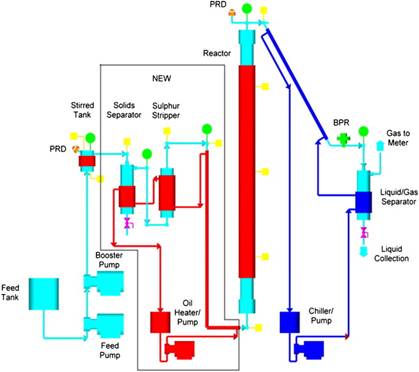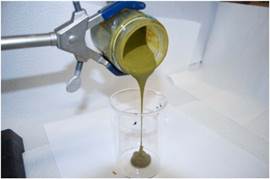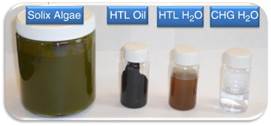实验室里水藻变原油不到一小时
来源:《藻类研究》
作者:Douglas Elliott
时间:2013-12-25



据物理学家组织网12月19日(北京时间)报道,美国能源部西北太平洋国家实验室(PNNL)研究人员开发出一种可持续化学反应,在加入海藻后很快就能产出有用的原油。犹他州一家生物燃料公司(Genifuel Corp.)已获该技术许可,正在用该技术建实验工厂。相关论文在线发表最近出版的《藻类研究》杂志上。
“从某种意义上说,我们‘复制’了自然界用百万年把水藻转化为原油的过程,而我们转化得更多、更快。”PNNL小组研究负责人道格拉斯·埃利奥特说。研究小组保持了水藻高效能优势,并结合多种方法来降低成本。他们把几个化学步骤合并到一个可持续反应中,简化了从水藻到原油的生产过程。用湿水藻代替干水藻参加反应,而当前大部分工艺都要求把水藻晒干。新工艺用的是含水量达80%—90%的藻浆。
在新工艺中,像泥浆似的湿水藻被泵入化学反应器的前端。系统开始运行后,不到一小时就能向外流出原油、水和含磷副产品。再通过传统工艺提纯,就可以把“原藻油”转变成航空燃料、汽油或柴油。在实验中,通常超过50%的水藻中的碳转化为原油能量,有时可高达70%;废水经过处理,能产出可燃气体和钾、氮气等物质。可燃气体可以燃烧发电,或净化后制造压缩天然气作汽车燃料;氮磷钾等可作养料种植更多水藻。“这不仅大大降低成本,而且能从水中提取有用气体,用剩下的水来种藻,进一步降低成本。”埃利奥特说。
他们还取消了溶剂处理步骤,把全部水藻加入高温高压(约350℃、3,000PSI)的水中分离物质,结合一种水热液化与催化水热气化反应,把大部分生物质转化为液体和气体燃料。埃利奥特指出,要建造这种高压系统并非易事,造价较高,这是该技术的一个缺点,但后期节约的成本会超过前期投资。
其他团体也有研究用湿水藻的,但一次只能生产一批,而新反应系统能持续运行。在实验室,反应器每小时能处理约1.5升藻浆。这虽然不多,但这种持续系统更接近大规模商业化生产。Genifuel公司总裁詹姆斯·奥伊勒也表示:“造出成本能和石油燃料竞争的生物燃料是一个很大挑战,我们朝着正确方向迈出了一大步。” (来源:科技日报 常丽君)
Process development for hydrothermal liquefaction of algae feedstocks
in a continuous-flow reactor
Abstract Wet algae slurries can be converted into an upgradeable biocrude by hydrothermal liquefaction (HTL). High levels of carbon conversion to gravity separable biocrude product were accomplished at relatively low temperature (350 °C) in a continuous-flow, pressurized (sub-critical liquid water) environment (20 MPa). As opposed to earlier work in batch reactors reported by others, direct oil recovery was achieved without the use of a solvent and biomass trace components were removed by processing steps so that they did not cause process difficulties. High conversions were obtained even with high slurry concentrations of up to 35 wt.% of dry solids. Catalytic hydrotreating was effectively applied for hydrodeoxygenation, hydrodenitrogenation, and hydrodesulfurization of the biocrude to form liquid hydrocarbon fuel. Catalytic hydrothermal gasification was effectively applied for HTL byproduct water cleanup and fuel gas production from water soluble organics, allowing the water to be considered for recycle of nutrients to the algae growth ponds. As a result, high conversion of algae to liquid hydrocarbon and gas products was found with low levels of organic contamination in the byproduct water. All three process steps were accomplished in bench-scale, continuous-flow reactor systems such that design data for process scale-up was generated.
原文链接:http://www.sciencedirect.com/science/article/pii/S2211926413000878




